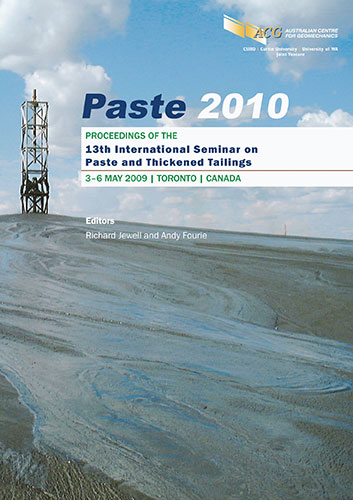Electrokinetic belt press dewatering of kimberlite tailings — case study of a full scale field trial

|
Authors: Lamont-Black, J; Jones, CJFP; Fourie, AB; Krüger, L Paper is not available for download Contact Us |
DOI https://doi.org/10.36487/ACG_rep/1063_29_Lamont-Black
Cite As:
Lamont-Black, J, Jones, CJFP, Fourie, AB & Krüger, L 2010, 'Electrokinetic belt press dewatering of kimberlite tailings — case study of a full scale field trial', in R Jewell & AB Fourie (eds), Paste 2010: Proceedings of the Thirteenth International Seminar on Paste and Thickened Tailings, Australian Centre for Geomechanics, Perth, pp. 329-342, https://doi.org/10.36487/ACG_rep/1063_29_Lamont-Black
Abstract:
In the continuum of tailings dewatering, filtration is at one of a number of technologies routinely employed. Filtration rates are increased by steepening the hydraulic pressure gradient across the tailings by using vacuum and or pressure. Two common drawbacks associated with fine grained materials are (i) low hydraulic permeability such that flow rates are small and (ii) clogging and/or blinding of the filter medium e.g. a filter belt. Both effects reduce the overall dewatering rate. An alternative belt press technique is described in this paper, utilising newly developed conductive polymeric belts to produce filter belts that can be used to dewater ultrafine material using electro-osmosis. In April 2008 a full scale trial to dewater ultrafine kimberlite tailings was undertaken using an electrokinetic belt filter press. The trial successfully dewatered a stream of kimberlite paste at approximately 50% dry solids content to produce a stable solid cake at approximately 75% dry solids. The paper describes the trial and gives details of the technical and financial benefits that the electrokinetic technique offers to the treatment and disposal of paste including: significant recovery of water; significant reduction in energy usage; reduction in the volume of waste to be discarded; and a reduction in the cost of tailings waste disposal. The development of electrokinetic dewatering of tailings has other potential advantages including the elimination of the need for slimes dams in their current form and replacement by compacted landforms that pose considerably lower geotechnical and environmental risk.
References:
Lamont-Black, J., Jones, C.J.F.P., Glendinning, S., Huntley, D.T. and Fourie, A.B. (2007) Laboratory evaluation of the
potential for electrokinetic belt filter press dewatering of kimberlite slimes, in Proceedings Tenth International
Seminar on Paste and Thickened Tailings, Australian Centre for Geomechanics, Perth Australia,
pp. 147–152.
Mitchell, J.K. and Soga, K. (2005) Fundamentals in Soil Mechanics, John Wiley & Sons Inc.
Pavlakis, J. (2002) Electro osmotic dewatering of mine tailings using geosynthetics, Presentation to the 7th International
Conference on Geosynthetics, Nice, France, September 2002.
Vietti, A. (2004) Know your chemistry – suspension and compaction behaviour of paste, in Proceedings 7th
International Seminar on Paste and Thickened Tailings, Australian Centre for Geomechanics, Perth Australia,
Paper 11.
Vietti, A. and Dunn, F. (2003) Paste and Thickened Tailings Handbook, Vietti, A. and Dunn, F. (eds), De Beers
Technical Support Services, Johannesburg, South Africa.
Wilmans, W. and Van Deventer, J.S.J. (1987) Electrokinetic solid-liquid separation of an ultrafine kimberlite
suspension, Journal of the South African Institute of Mining and Metallurgy, 87 (2), p. 41–52.
© Copyright 2025, Australian Centre for Geomechanics (ACG), The University of Western Australia. All rights reserved.
View copyright/legal information
Please direct any queries or error reports to repository-acg@uwa.edu.au
View copyright/legal information
Please direct any queries or error reports to repository-acg@uwa.edu.au